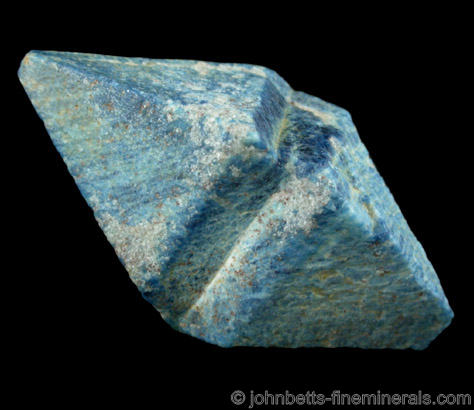The Mineral lazulite

Lazulite is an aesthetic blue mineral that forms in distinct crystals. Its name is very similar and often confused with Lazurite, which is an entirely different mineral species. However, the names of both these minerals are derived from the term "Lazaward", which means heaven in Arabic, alluding to their blue color.
Lazulite forms a series with the rare mineral Scorzalite, which is the iron-rich equivalent of Lazulite.
Chemical Formula
(Mg,Fe)Al2(PO4)2(OH)2
Color
Dark indigo-blue to almost black, sky-blue, light blue, grayish-blue, and greenish-blue. May also have intermixed white or creamy streaks or splotches, or be multicolored blue and blue-green. Transparent Lazulite is pleochroic.
Crystal System
Monoclinic
Properties
Streak
White |
Hardness
5.5 - 6 |
Transparency
Transparent to opaque |
Specific Gravity
3.0 - 3.1 |
Luster
Vitreous to dull |
Cleavage
3,1 |
Fracture
Uneven |
Tenacity
Brittle |
Crystal Habits
Crystal habits include steep bipyramidal or wedge-shaped crystals. Crystals are usually small and embedded in a matrix. Also tabular, in dense crystal masses, in aggregates of distorted or damaged crystals, grainy, and massive. Crystals are sometimes etched, and occasionally twinned.
Uses
Lazulite is a popular collectors mineral, and specimens from Graves Mountain (Georgia) and Rapid Creek (Yukon) are especially desirable. Specimens embedded in white Quartz, especially those from Austria, are sometimes sliced into slabs or polished for collectors. Lazulite is occasionally used a minor collectors gemstone.
Noteworthy Localities
One of the most famous localities for Lazulite is Graves Mountain, Lincoln Co., Georgia, which produced well-formed blue crystals embedded in a crumbly Quartz matrix. The locality of Rapid Creek (and nearby Crosscut Creek), in the Yukon Territory of Canada is also well-known for its outstanding transparent dark blue Lazulite crystals.
Austria is a classic producer of Lazulite, with the noteworthy localities of Fischbach, in Styria; and Werfen, in Salzburg. In Italy, Lazulite comes from the Vizze pass, Bolzano Province; and from Monte Folgorito, Pietrasanta, Lucca Province. Exceptionally large and gemmy distorted crystals came from Laila, Gilgit District, Pakistan.
Other U.S. occurrences are the Champion Mine, Mono Co., California; and North Groton, Grafton County, New Hampshire.
Common Mineral Associations
Quartz, Hematite, Muscovite, Pyrophyllite, Siderite, Topaz, Augelite, Wardite
Distingushing Similar Minerals
Lazurite - Different crystal habit, has a blue streak and lower specific gravity.
Scorzalite - Difficult to distinguish, though usually darker in color and higher specific gravity.
Sodalite - Difficult to distinguish, though usually has white veins and strong fluorescence.